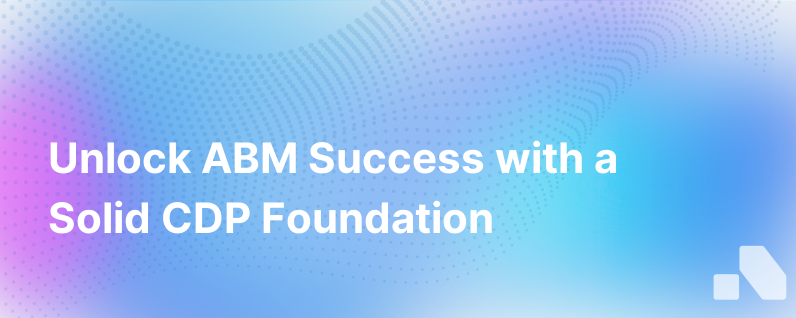Good Account Based Marketing Starts With A Cdp
Published on December 11, 2023 by Sawyer Middeleer
In an age where data is the new currency, businesses are steadily shifting towards customer-centric marketing strategies. Account-Based Marketing (ABM) is a strategic framework that concentrates sales and marketing resources on a clearly defined set of target accounts within a market and employs personalized campaigns designed to resonate with each account. Leveraging ABM, businesses can align marketing and sales efforts to turn high-value targets into customers. Today, a Customer Data Platform (CDP) isn't just a component of cutting-edge ABM strategies – it's foundational.
Understanding the Role of a CDP in ABM
A Customer Data Platform is a unified database that stores all customer data from various sources, consolidating it into individual profiles. This data can then be segmented for targeted marketing efforts. In the context of ABM, a CDP helps refine target account selection, unveil insights, drive personalized engagement, and measure campaign performance.
Account Selection and Insights
A CDP organizes disparate data sources into comprehensive, unified customer profiles. This high-resolution view into potential accounts allows you to identify your ideal customer profile (ICP) and select accounts with the greatest potential for engagement and conversion. Key details such as industry, revenue, product usage, support interactions, and customer behavior are integrated within a CDP, providing marketers with the insights needed to tailor their ABM strategies effectively.
Within a CDP, data analysis tools can assist in uncovering trends and patterns that may direct ABM efforts. For instance, frequent issues reported by companies within a certain industry might reveal an inclination toward your solution. Critical attributes can be highlighted, such as which accounts are showing buying signals like increased website visits or content engagement, streamlining further focus and resources.
Personalizing Experiences Across Channels
ABM thrives on personalization. It’s about delivering a bespoke message that resonates with a specific account's needs and challenges. Herein, a CDP becomes a powerhouse, enabling you to craft messages that speak directly to an account's pain points, industry nuances, position in the buyer's journey, and even previous interactions with your brand.
Once an account has been engaged, the CDP continues to play an essential role. It captures interactions across channels – website, email, social, and more – and feeds this data back into the customer profile. Sales and marketing teams can access a consistent, real-time view of each account's engagement, refining their ongoing approach for maximum impact.
Measuring Campaign Performance
ABM isn't a 'set it and forget it' strategy; it requires continual optimization. A CDP collects and centralizes account engagement data, empowering marketing teams to monitor multi-channel campaign performance with precision. Real-time access to data helps teams make agile decisions, adjusting campaigns to improve engagement, refine messaging, and ultimately, convert targets into customers.
Assessing ROI on ABM campaigns is also made simpler with a CDP. Integrating financial data allows businesses to correlate marketing efforts with revenue growth, which is particularly crucial for justifying investments in ABM strategies and directing future funding.
Best Practices for Integrating a CDP with ABM
- Data Hygiene: Before leveraging a CDP for ABM, it’s vital to ensure that the data is clean and up-to-date. Scrub the database for duplicates, outdated information, and incomplete profiles.
- Integrations: Your CDP should be integrated with all the tools in your marketing stack to centralize data collection. This may include your CRM, marketing automation platform, website analytics tools, and social listening platforms.
- Segmentation: Use the detailed customer profiles in your CDP to segment accounts based on various attributes, including demographic, firmographic, technographic, and behavioral data. This allows for laser-focused campaign targeting.
- Content Personalization: Customized content is the cornerstone of ABM. Use insights from your CDP to create content that aligns with each target account's unique challenges and interests.
- Cross-functional Access: Ensure that both marketing and sales have access to the CDP. This alignment ensures everyone is working from the same data set and can personalize their interactions, whether it’s in marketing outreach or sales conversations.
- Testing and Learning: Use A/B testing to determine which messages are resonating best with your target accounts and adjust accordingly. CDPs can provide invaluable feedback on performance metrics and help identify patterns.
Conclusion
Implementing an ABM strategy without a solid foundation of customer data is like navigating without a compass. It's theoretically possible, but the path is fraught with inefficiencies, missed opportunities, and potential setbacks. A CDP solves this by centralizing customer data as an accessible, actionable asset, facilitating more strategic and personal engagements with each target account - the very essence of ABM.
In the modern marketing landscape, a CDP isn't just another tool in the shed; it's an integral component of successful ABM. It empowers organizations to move away from broad, generic marketing campaigns to a more precise and personalized approach. In short, effective ABM starts with the detailed customer insight only a CDP can provide.
Embracing this reality, many forward-thinking companies are investing in comprehensive Customer Data Platforms to drive their ABM initiatives forward. Whether you're a burgeoning startup or an established enterprise, the interplay between ABM and a CDP can significantly enhance your marketing efforts – aligning your sales and marketing teams, refining your outreach, and delivering a customer experience that drives growth. In the end, good Account-Based Marketing doesn't just start with a CDP; it flourishes with it.